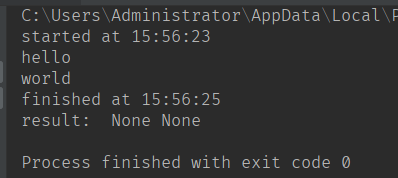说明:需要Python 3.7+
1、并发运行两个coroutine,写法一: 用Task
import asyncio import time async def say_after(delay, what): await asyncio.sleep(delay) print(what) async def main(): task1 = asyncio.create_task( say_after(1, 'hello')) task2 = asyncio.create_task( say_after(2, 'world')) print(f"started at {time.strftime('%X')}") # Wait until both tasks are completed (should take around 2 seconds.) r1 = await task1 r2 = await task2 print(f"finished at {time.strftime('%X')}") print("result: ", r1, r2) asyncio.run(main())
运行时间:2s

1、并发运行两个coroutine,写法二: 用 gather
import asyncio import time async def say_after(delay, what): await asyncio.sleep(delay) print(what) async def main(): print(f"started at {time.strftime('%X')}") result = await asyncio.gather(say_after(1, 'hello'), say_after(2, 'world')) print(f"finished at {time.strftime('%X')}") print("result: ", result) asyncio.run(main())
运行时间:2s

说明:
一、使用async def 将方法变成协程,用await修饰有阻塞的操作
二、await后可跟三种类型: 协程, 任务 和 Future.